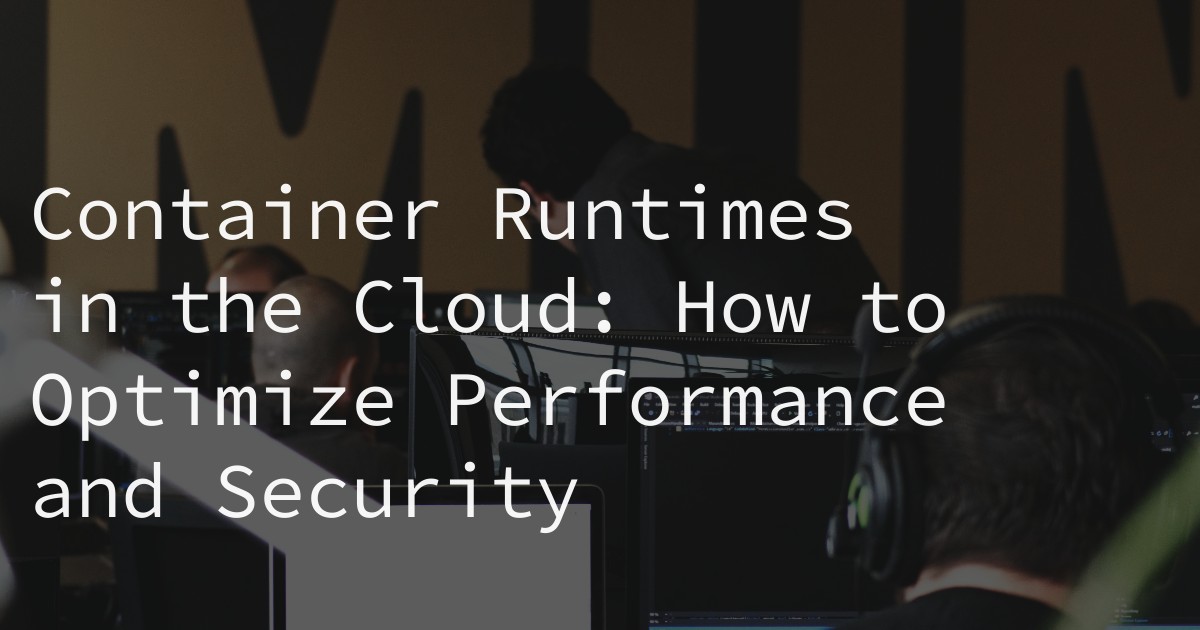
05 Nov Container Runtimes in the Cloud: How to Optimize Performance and Security
Container runtimes have become an integral part of cloud computing, providing a lightweight and efficient way to deploy and manage applications. With the rise of cloud-native computing, container runtimes have gained even more prominence, making it crucial for businesses to understand how to optimize their performance and security in the cloud. In this article, we will delve into the world of container runtimes in the cloud, exploring their benefits, best practices for usage, and strategies for ensuring performance and security. By the end, you will have a comprehensive understanding of how to leverage container runtimes in the cloud for maximum efficiency and effectiveness.
Understanding Container Runtimes
Container runtimes are software tools that allow for the creation, deployment, and management of containers in a cloud environment. Containers are self-contained packages that include all the necessary components for an application to run, making them highly portable and efficient. Some popular container runtimes include Docker, rkt, and containerd, each with its own unique features and capabilities.
When it comes to cloud computing, container runtimes offer several advantages. They allow for faster deployment and scaling of applications, reduce resource usage and costs, and provide a consistent environment for development and testing. Additionally, container runtimes can be easily integrated with other cloud services, making them a valuable tool for modern cloud-native architectures.
Best Practices for Using Container Runtimes in the Cloud
Choosing the right container runtime for your specific needs and workload is crucial for optimizing performance and efficiency in the cloud. Some factors to consider when selecting a container runtime include compatibility with your operating system, support for your programming language, and the level of community support and updates.
Once you have selected a container runtime, it is important to configure it properly for optimal performance. This includes setting resource limits, optimizing network settings, and utilizing features such as caching and compression. Additionally, container orchestration tools like Kubernetes can help with managing and scaling container runtimes in a cloud environment.
Security is also a critical aspect to consider when using container runtimes in the cloud. It is important to implement measures such as image scanning, access control, and vulnerability management to protect against potential attacks and breaches.
Ensuring Performance in Container Runtimes
Several factors can affect the performance of container runtimes in the cloud, including resource allocation, network latency, and application design. To optimize performance, it is important to carefully allocate resources to containers based on their workload and prioritize critical applications. Load balancing can also help distribute traffic evenly and prevent any single container from becoming overloaded.
Monitoring and troubleshooting techniques are also essential for identifying and resolving performance issues in container runtimes. This includes monitoring resource usage, network traffic, and application performance, as well as utilizing tools for debugging and troubleshooting.
Ensuring Security in Container Runtimes
As with any technology, container runtimes come with their own set of security risks. These can include vulnerabilities in the container images, misconfigured access controls, and potential attacks on the host system. To mitigate these risks, it is important to follow best practices for securing container runtimes, such as regularly scanning images for vulnerabilities, implementing access controls, and keeping the runtime up to date with security patches.
Integrating container runtimes with other cloud services can also enhance security. For example, integrating with identity and access management tools can help ensure that only authorized users have access to the containers, while integrating with storage and networking services can provide additional layers of security for data and network traffic.
Integrating Container Runtimes with Other Cloud Services
Integrating container runtimes with other cloud services can bring numerous benefits, such as improved scalability, reliability, and security. For example, integrating with a cloud storage service can provide persistent storage for containers, while integrating with a cloud networking service can help manage network traffic and security policies.
When integrating container runtimes with other cloud services, it is important to follow best practices for seamless integration and management. This includes utilizing APIs and automation tools, as well as implementing monitoring and logging for better visibility and control.
Conclusion
In conclusion, container runtimes have become an essential tool for cloud computing, providing a lightweight and efficient way to deploy and manage applications. By following best practices for usage and optimization, as well as implementing security measures, businesses can ensure maximum performance and security in their container runtimes. As cloud-native computing continues to evolve, container runtimes will play an even bigger role in enabling businesses to achieve their goals in the cloud.
RELATED ARTICLES:



Sorry, the comment form is closed at this time.